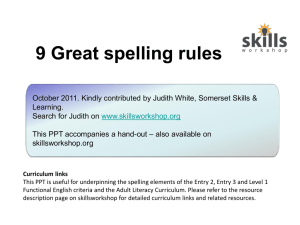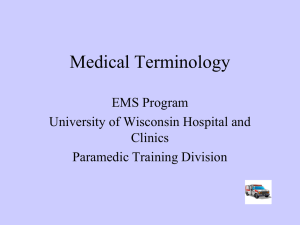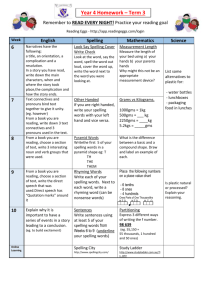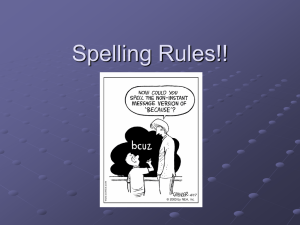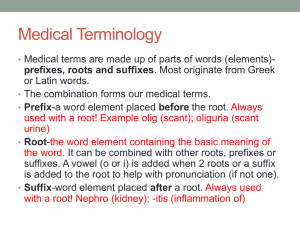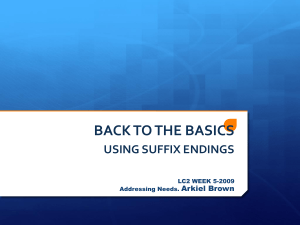Year 4 - Group 5
advertisement
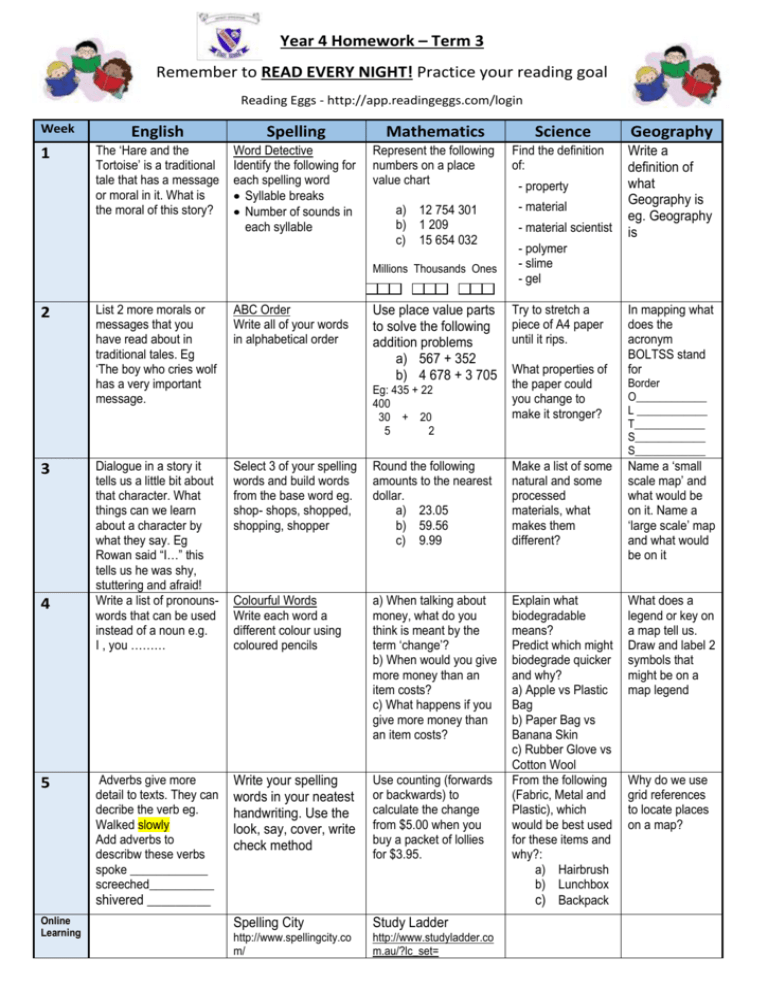
Year 4 Homework – Term 3 Remember to READ EVERY NIGHT! Practice your reading goal Reading Eggs - http://app.readingeggs.com/login Week 1 English Spelling Mathematics The ‘Hare and the Tortoise’ is a traditional tale that has a message or moral in it. What is the moral of this story? Word Detective Identify the following for each spelling word Syllable breaks Number of sounds in each syllable Represent the following numbers on a place value chart a) 12 754 301 b) 1 209 c) 15 654 032 Millions Thousands Ones 2 3 4 5 Use place value parts to solve the following addition problems a) 567 + 352 b) 4 678 + 3 705 Find the definition of: - property - material - material scientist Geography Write a definition of what Geography is eg. Geography is - polymer - slime - gel List 2 more morals or messages that you have read about in traditional tales. Eg ‘The boy who cries wolf has a very important message. ABC Order Write all of your words in alphabetical order Dialogue in a story it tells us a little bit about that character. What things can we learn about a character by what they say. Eg Rowan said “I…” this tells us he was shy, stuttering and afraid! Write a list of pronounswords that can be used instead of a noun e.g. I , you ……… Select 3 of your spelling words and build words from the base word eg. shop- shops, shopped, shopping, shopper Round the following amounts to the nearest dollar. a) 23.05 b) 59.56 c) 9.99 Make a list of some natural and some processed materials, what makes them different? Name a ‘small scale map’ and what would be on it. Name a ‘large scale’ map and what would be on it Colourful Words Write each word a different colour using coloured pencils a) When talking about money, what do you think is meant by the term ‘change’? b) When would you give more money than an item costs? c) What happens if you give more money than an item costs? What does a legend or key on a map tell us. Draw and label 2 symbols that might be on a map legend Adverbs give more detail to texts. They can decribe the verb eg. Walked slowly Add adverbs to describw these verbs spoke ____________ screeched__________ Write your spelling words in your neatest handwriting. Use the look, say, cover, write check method Use counting (forwards or backwards) to calculate the change from $5.00 when you buy a packet of lollies for $3.95. Explain what biodegradable means? Predict which might biodegrade quicker and why? a) Apple vs Plastic Bag b) Paper Bag vs Banana Skin c) Rubber Glove vs Cotton Wool From the following (Fabric, Metal and Plastic), which would be best used for these items and why?: a) Hairbrush b) Lunchbox c) Backpack Spelling City Study Ladder http://www.spellingcity.co m/ http://www.studyladder.co m.au/?lc_set= Eg: 435 + 22 400 30 + 20 5 2 shivered _________ Online Learning Science Try to stretch a piece of A4 paper until it rips. What properties of the paper could you change to make it stronger? In mapping what does the acronym BOLTSS stand for Border O____________ L ____________ T____________ S____________ S____________ Why do we use grid references to locate places on a map? SPELLING FOR GROUP FIVE TERM 3 2015 WEEK 1 Consolidation Yr 4 Unit 1 Week 5 & Unit 2 Week 1 Complex Consonants – ‘dge’ ‘str’ ‘tch’ ‘squ’ Silent letters - ‘tch’ ‘kn’ ‘gn’ ‘wr’ sketch squirt stretch squawk hutch squirrel catch squeeze latch knotted knuckle square knitting gnocchi knead gnashing knowledge wrinkle edge wrapped judge The ‘tch’ pattern is most often following a short vowel (pitch) while ‘ch’ is often after another consonant or vowel pattern (lunch, reach). LEM rules – ‘wr’and ‘kn’ may only be used to represent ‘r’ at the beginning of a base word. ‘tch’ is usually used to represent the sound ch after a single vowel in a one syllable word. The vowel does not always say its first sound. ‘gn’ may be used to represent the sound ‘n’ at the beginning or at the end of a base word. ‘dge’ may only be used to represent the sound ‘j’ at the end of a word after a single vowel which says its first sound – a, e, i, o or u. WEEK 3 Focus Area AFFIXES Yr 6 Unit 1 Week 2 Suffixes — ‘ance’, ‘ence’ Yr 4 Unit 4 Wk 4 Suffix – ‘ous’ WEEK 2 Consolidation Yr 4 Unit 2 Week 2 Vowels – diphthongs ‘oi’ ‘oy’ and ‘ou’ Yr 4 Unit 1 Week 4 Doubling Final Consonant disloyal allow voice amount moisture doubt dough through employ ground voyage avoid wrapping trapped shopping hottest quitting spotty dragged knotty stopped tripped WEEK 3 Focus Area – WEEK 4 Focus Area – WEEK 5 Focus Area - Unaccented final syllables Yr 4 Unit 3 Week 3 Unaccented final syllables — ‘le’ and ‘el’ Unaccented final syllables Yr 4 Unit 3 Week 4 Unaccented final syllables — ‘il’ and ‘al’ Unaccented final syllables Yr 4 Unit 4 Week 3 Final syllables — ‘er’, ‘ar’ and ‘or’ principle candle example double miracle staple handle vehicle couple tremble council pencil nostril April civil tonsil stencil pupil fossil principal another border answer reporter gather whether rather burglar collar lunar jewel fuel caramel level quarrel novel hotel tunnel cancel funnel normal journal animal material social equal festival special dental hospital solar popular regular similar familiar mirror meteor cursor editor visitor Unit 2 - A diphthong is a vowel sound that glides from one sound to another in a quick, smooth movement. Ambiguous vowels can be challenging to spell as the same pattern can make different sounds, such as ‘ou’ in ‘dough’ and ‘through’ Unit 1 - Doubling consonants at the syllable juncture preserves the short vowel sound e.g. ‘hŏp’ becomes ‘hŏp/ping’. If the consonant is not doubled the syllable becomes open and the vowel can become long e.g. ‘hŏp’ – ‘hō/ping’. Exceptions to this generalisation include most words that end in ‘w’ (draw) or ‘x’ (wax). LEM Rules – ‘oi’ – may not be used at the end of word. English words don’t end in ‘I’. Can be used within a syllable. ‘oy’ is used to represent the sound ‘oy’ at the end of a syllable if a vowel follows (voyage, foyer, royal, disloyal) Words with the final syllables ‘le’, ‘el’, ‘il’ and ‘al’ can be challenging to spell as the difference cannot always be heard. For example, ‘principle’, ‘level’, ‘pencil’ and ‘dental’. The syllables are unaccented or have less stress. The vowel sound is neither short nor long. It is useful to remember that the ending ‘le’ is far more common than ‘el’. Use your visual spelling knowledge to learn the shape and spelling of these words. Words with the final syllables ‘le’, ‘el’, ‘il’ and ‘al’ can be challenging to spell as the difference cannot always be heard. For example, ‘principle’, ‘level’, ‘pencil’ and ‘dental’. The syllables are unaccented or have less stress. The vowel sound is neither short nor long. It is useful to remember that the ending ‘le’ is far more common than ‘el’. Use your visual spelling knowledge to learn the shape and spelling of these words. The final syllables ‘er’, ‘ar’ and ‘or’ are usually unaccented (unstressed) syllables making it difficult to hear the difference in the vowel sound. There are a few generalisations that may assist in remembering these words: •comparatives are always spelt ‘er’ •the final syllable ‘er’ is more common than ‘ar’ or ‘or’ •adding a suffix may help to hear the difference e.g. similar – similarity. Use visual spelling knowledge. WEEK 4 Focus Area AFFIXES Yr 4 Unit 4 Week 4 Suffixes — ‘tion’, ‘ous’, ‘y’ and ‘ish’ WEEK 5 Focus Area – AFFIXES Yr 4 Unit 3 Week 5 Prefixes — ‘un’, ‘re’, ‘dis’ and ‘mis’ WEEK 3 Focus Area – AFFIXES Yr 5 Unit 7 Week 5 Suffixes — ‘able’, ‘ible, ‘ous’ and ‘eous’ WEEK 4 Focus Area – AFFIXES Yr 5 Unit 2 Week 3 Suffixes — ct + ‘ion’, ss + ‘ion’, t + ‘ion’ and ‘e’ drop + ‘ion’ acceptance anxious appearance famous guidance jealous defiance disastrous instance dependence confidence patience intelligence difference The suffix ‘tion’ changes words into nouns, for example educate (verb) – education (noun). The suffix ‘ous’, ‘y’ and ‘ish’ form adjectives, for example fame (noun) – famous (adjective); thirst (noun) – thirsty (adjective); child (noun) – childish (adjective). The suffixes ‘tion’ and ‘ish’ mean ‘state of being’. The suffix ‘ous’ means ‘full of’ and the suffix ‘y’ means ‘like’. education cloudy collection thirsty illustration hungry concentration fussy separation nosey anxious childish famous foolish jealous stylish disastrous longish dirty selfish The suffix ‘tion’ changes words into nouns, for example educate (verb) – education (noun). The suffix ‘ous’, ‘y’ and ‘ish’ form adjectives, for example fame (noun) – famous (adjective); thirst (noun) – thirsty (adjective); child (noun) – childish (adjective). The suffixes ‘tion’ and ‘ish’ mean ‘state of being’. The suffix ‘ous’ means ‘full of’ and the suffix ‘y’ means ‘like’. unusual disagree unclean dishonest unable discovery unhappy disappear uncommon disobey research mistrust recharge mistook recycle misspell refill misprint remind misbehave Prefixes change the meaning of the base word. The prefixes ‘un’ and ‘dis’ mean not; ‘re’ means again; and ‘mis’ means wrong. Knowing the meanings of prefixes helps with word building and making meaning. For example: ‘unbelievable’ means not believable; ‘disagree’ means to not agree; ‘refill’ means to fill again fashionable suitable comfortable favourable agreeable changeable responsible horrible eligible incredible possible edible visible joyous dangerous mysterious humorous famous gorgeous courteous Suffixes are morphemes that are placed at the end of words (or base words). Suffixes change the base word and how it is used. Suffixes can turn words into nouns, adjectives, adverbs or verbs. The suffix ‘able’ is usually added to base words (for example, fashion/able), while the suffix ‘ible’ is usually added to root words (for example, horr/ible). The suffixes ‘able’ and ‘ible’ sound the same. Sometimes it can be difficult to work out which suffix to use based on sound alone. The suffix ‘able’ is usually found at the end of a whole word. For example, ‘comfort’, ‘fashion’ and ‘favour’ are whole base words. Adding the suffix ‘able’ makes the words ‘comfortable’, ‘fashionable’ and ‘favourable’. The suffix ‘ible’ is usually found at the end of a root word. For example, ‘incred’, ‘horr’ and ‘elig’. These are not whole words. The suffix ‘ible’ is used to make the words ‘incredible’, ‘horrible’ and ‘eligible’. An easy way to remember the difference is ‘able’ is a whole word, while ‘ible’ is not! The suffixes ‘able’ and ‘ible’ are usually adjective-forming (e.g. comfortable, incredible). The suffixes ‘ous’ and ‘eous’ are usually adjective-forming (e.g. joyous, courteous). These suffixes mean ‘like, full of’ or ‘relating to’. introduction interruption direction suggestion selection prevention correction exception instruction communication expression illustration submission location transmission frustration discussion decoration profession pollution Suffixes are morphemes placed at the end of words to change how the word is used. The suffix ‘ion’ changes words into nouns. This suffix has been added to base words ending in ‘ct’ (selection), ‘ss’ (express) and ‘t’ (exception). Explore the base words and how some endings change. Base words that end in ‘e’ will usually drop the ‘e’ before adding the suffix ‘ion’ (e.g. frustrate - frustration); the final ‘t’ changing to ‘ss’ in words such as ‘submit’ and ‘transmit’. This suffix makes a /shun/ sound when added to base words.
